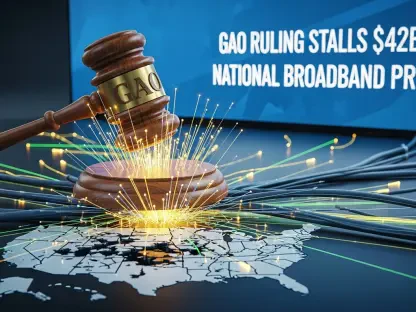In a remarkable turn of events that has captivated the telecom industry and financial markets, EchoStar Corp (SATS) experienced an extraordinary surge in its stock price, climbing 70.25% to close at $50.87 on August 26. This dramatic rise was triggered by the announcement of a groundbreaking $23 billion all-cash deal with AT&T, involving the sale of a substantial portfolio of wireless spectrum licenses. The transaction, one of the most significant in recent telecom history, has not only reshaped EchoStar’s financial standing but also sent ripples through the competitive landscape of U.S. wireless communications. Investors and industry observers are abuzz with speculation about the long-term implications of this deal, which provides EchoStar with a massive capital infusion while positioning AT&T to strengthen its 5G network capabilities. As this monumental agreement unfolds, it underscores the critical importance of spectrum as a resource and highlights the strategic maneuvering within a rapidly evolving sector.
The sheer scale of the $23 billion transaction has drawn widespread attention, marking a pivotal moment for EchoStar, as it secures an immediate financial windfall that promises to alleviate past pressures and open doors to new opportunities. Beyond the numbers, the agreement signifies a strategic shift, granting EchoStar the flexibility to redefine its role in the telecom arena. Meanwhile, AT&T’s acquisition of 50 MHz of spectrum enhances its competitive edge, intensifying the 5G race among industry giants. The market’s enthusiastic response, reflected in EchoStar’s stock performance, speaks to a renewed confidence in the company’s future direction. As the deal progresses toward an expected closure by mid-2026, pending regulatory approval, anticipation builds around how EchoStar will leverage its strengthened position and remaining assets to drive innovation and growth in a dynamic industry landscape.
Financial Impact of the Deal
Immediate Capital Boost and Debt Reduction
The $23 billion all-cash transaction with AT&T represents a transformative financial milestone for EchoStar, delivering an unprecedented influx of capital that reshapes the company’s balance sheet. This substantial sum is earmarked for multiple critical purposes, including the retirement of significant debt obligations that have long weighed on the company’s financial health. By reducing leverage, EchoStar mitigates risk and enhances its stability, creating a more robust foundation for future endeavors. The immediate impact of this capital boost is evident in the market’s reaction, as investors recognize the potential for a healthier financial profile. Management has emphasized that these funds will also support ongoing operations, ensuring that day-to-day activities remain unaffected during this period of transition. This financial overhaul positions EchoStar to weather economic uncertainties with greater confidence, setting a precedent for how strategic asset sales can redefine a company’s trajectory in the telecom sector.
Beyond debt reduction, the capital from this deal provides EchoStar with a rare opportunity to allocate resources toward strategic priorities that were previously out of reach. A strengthened balance sheet means the company can now address long-standing financial constraints and invest in areas that promise sustainable growth. This could include bolstering operational infrastructure or funding research into emerging technologies that align with industry trends. The significance of this financial flexibility cannot be overstated, as it alleviates pressures that might have hindered innovation or expansion efforts in the past. Additionally, the influx of cash enhances EchoStar’s creditworthiness, potentially lowering borrowing costs for future initiatives. This newfound fiscal resilience is a key factor behind the surge in investor optimism, as it signals a shift from a position of constraint to one of empowerment, allowing the company to pursue a more proactive and forward-looking financial strategy.
Long-Term Financial Stability and Reinvestment
The financial implications of the $23 billion deal extend far beyond immediate relief, laying the groundwork for EchoStar’s long-term stability in a competitive industry. With debt burdens significantly reduced, the company can redirect focus toward building a sustainable economic model that prioritizes resilience and growth. This stability is crucial in an era where telecom companies face constant pressure to adapt to technological advancements and shifting consumer demands. The capital infusion provides a buffer against market volatility, enabling EchoStar to maintain steady operations even in challenging economic climates. Moreover, the strengthened financial position enhances the company’s ability to attract partnerships or investments, as stakeholders view it as a more reliable and less risky entity. This deal, therefore, acts as a catalyst for a broader transformation, ensuring that EchoStar is not merely surviving but positioning itself to thrive over the coming years.
Another critical aspect of this financial windfall is the opportunity for reinvestment into core business areas and innovative projects, allowing EchoStar to strengthen its position in the market. EchoStar now has the resources to explore new revenue streams, whether through enhancing existing services or venturing into untapped markets within the telecom space. The funds can also support capital expenditures necessary for upgrading infrastructure, which is vital for maintaining competitiveness in a sector driven by technological progress. Management’s commitment to leveraging this capital for strategic growth initiatives suggests a forward-thinking approach that could yield significant returns for shareholders. As the company navigates this reinvestment phase, the focus will likely be on balancing immediate operational needs with long-term ambitions, ensuring that every dollar is allocated to maximize impact. This strategic reinvestment is poised to redefine EchoStar’s market presence, reinforcing its role as a key player in the evolving telecom landscape.
Strategic Shift for EchoStar
New Flexibility and Growth Opportunities
The sale of spectrum licenses to AT&T for $23 billion marks a defining moment for EchoStar, granting the company unparalleled strategic flexibility to chart a new course in the telecom industry. No longer encumbered by the uncertainty surrounding its spectrum assets, EchoStar can now pivot toward innovative business models that align with emerging market trends. This liquidity allows for exploration of next-generation technologies, such as advanced wireless solutions or satellite communications, which could position the company at the forefront of industry evolution. The deal also unlocks shareholder value by monetizing assets at a premium, a move that reflects astute timing amid heightened demand for spectrum. With reduced financial leverage, EchoStar gains the freedom to take calculated risks on growth opportunities that were previously constrained by debt obligations. This newfound agility is a cornerstone of the company’s strategy moving forward, setting the stage for a reimagined role in a fast-paced sector.
Equally important is the potential for EchoStar to pursue strategic acquisitions or partnerships that enhance its competitive standing, especially in a rapidly evolving industry. The substantial capital from the deal provides the means to invest in complementary businesses or technologies that can expand its market reach and diversify revenue streams. This could involve collaborations with tech innovators or even smaller telecom players to build a more robust ecosystem of services. Management’s ongoing evaluation of the remaining spectrum portfolio suggests that further value creation through asset monetization remains a possibility, adding another layer of strategic optionality. The extension of the wholesale network services agreement with AT&T, supporting the Boost Mobile brand, ensures operational continuity during this transition, allowing EchoStar to focus on long-term planning without immediate disruptions. This combination of financial strength and strategic clarity positions the company to seize unique opportunities in an industry ripe for transformation.
Positioning for Industry Leadership
With the financial and strategic boost from the $23 billion deal, EchoStar is well-placed to carve out a leadership role within the telecom sector over the coming years. The ability to invest in cutting-edge technologies and infrastructure upgrades provides a competitive edge, particularly as consumer demand for high-speed connectivity continues to soar. By focusing on innovation, the company can differentiate itself from peers and address evolving market needs, whether through enhanced 5G capabilities or alternative communication solutions. This proactive stance is critical in an industry where staying ahead of technological trends often determines market share. Additionally, the deal has elevated EchoStar’s visibility among industry stakeholders, potentially attracting talent and investment that further fuel its ambitions. As the company redefines its identity post-transaction, the emphasis on leadership will likely shape strategic decisions aimed at long-term dominance.
Another dimension of EchoStar’s repositioning is its potential to influence industry standards and practices through strategic alliances, making it a key player in the telecommunications sector. The interest from major players like Starlink and T-Mobile in its remaining spectrum assets underscores the company’s central role in ongoing consolidation efforts. Engaging in high-profile partnerships or collaborative projects could enable EchoStar to set benchmarks for innovation and service delivery, reinforcing its status as a trendsetter. The capital from the AT&T deal provides the resources to fund such initiatives, ensuring that the company is not just reacting to market shifts but actively driving them. This proactive approach also mitigates risks associated with rapid industry changes, as EchoStar can adapt swiftly to new challenges with solid financial backing. Ultimately, this strategic positioning aims to transform the company into a pivotal force, capable of shaping the future of telecom through bold moves and visionary planning.
Industry-Wide Implications
Reshaping the Telecom Landscape
The $23 billion spectrum deal between EchoStar and AT&T has profound implications for the U.S. telecom sector, particularly in the context of the ongoing race to dominate 5G technology. For AT&T, acquiring 50 MHz of spectrum—including 30 MHz of 3.45 GHz mid-band and 20 MHz of 600 MHz low-band airwaves—significantly enhances its network capacity and service quality. This acquisition strengthens AT&T’s position against rivals like Verizon and T-Mobile, enabling faster migration of customers to advanced broadband solutions and improved home internet infrastructure. The deal underscores the scarcity of spectrum as a critical resource, with its value amplified by the urgent need for robust 5G networks to meet consumer and enterprise demands. As AT&T bolsters its capabilities, the competitive dynamics of the industry shift, potentially prompting other players to seek similar strategic acquisitions to keep pace in this high-stakes environment.
Beyond AT&T’s gains, the transaction highlights broader trends of industry consolidation and the strategic importance of spectrum in today’s market. EchoStar’s ability to secure such a substantial price for its licenses reflects not only the scarcity of these assets but also the company’s savvy timing in capitalizing on peak demand. The deal has drawn attention from other industry giants, with reports suggesting that Starlink and T-Mobile are eyeing EchoStar’s remaining spectrum holdings. This interest signals that EchoStar remains a linchpin in the ongoing reshuffling of industry power, potentially setting the stage for further blockbuster transactions. The ripple effects of this deal could accelerate mergers and partnerships across the sector, as companies scramble to secure spectrum and other critical resources. In this context, EchoStar emerges as a key influencer, shaping the competitive landscape through its strategic decisions and asset management.
Spectrum Scarcity and Market Dynamics
The EchoStar-AT&T deal shines a spotlight on the critical issue of spectrum scarcity, a defining challenge for the telecom industry as demand for high-speed connectivity surges. Spectrum, often described as the lifeblood of wireless communications, is a finite resource, making transactions like this one highly consequential for market players. The $23 billion valuation of EchoStar’s 50 MHz portfolio underscores the premium placed on these airwaves, particularly as 5G technology becomes the standard for mobile and broadband services. For companies unable to secure additional spectrum, the risk of falling behind in network performance and customer satisfaction looms large. This scarcity drives fierce competition among telecom giants, pushing them to explore creative strategies—whether through acquisitions, partnerships, or regulatory advocacy—to gain access to the bandwidth necessary for future growth.
Moreover, the deal illustrates how spectrum transactions can alter market dynamics and influence strategic priorities across the industry. AT&T’s enhanced capabilities post-acquisition may pressure competitors to accelerate their own network expansion plans, potentially leading to a wave of investment in infrastructure and technology. For smaller players or new entrants, the high cost of spectrum acquisition poses a significant barrier, further consolidating power among established giants. EchoStar’s role in this dynamic is particularly noteworthy, as its remaining spectrum assets position it as a potential broker of future deals that could reshape alliances and rivalries. The broader implication is a telecom market increasingly defined by strategic asset management, where control over spectrum equates to control over market influence. As this trend continues, the industry will likely see intensified efforts to maximize the value of limited resources, with EchoStar at the center of this evolving narrative.
Investor Sentiment and Market Dynamics
Surge in Stock Value and Confidence
The market’s reaction to EchoStar’s $23 billion spectrum deal with AT&T has been nothing short of extraordinary, with the company’s stock surging 70.25% to close at $50.87 on August 26. This dramatic increase, positioning shares near a 52-week high, reflects a profound wave of investor optimism about the transaction’s implications. The scale of the all-cash deal, coupled with its immediate financial benefits, has fueled confidence in EchoStar’s ability to transform its business model and capitalize on new opportunities. This surge stands out even amid a backdrop of gains for other high-profile companies, underscoring the unique significance of this event for both institutional and retail investors. The market perceives the deal as a fundamental revaluation of EchoStar’s worth, driven by the promise of reduced debt and enhanced strategic flexibility, which together paint a picture of a company poised for a robust comeback.
Furthermore, the investor enthusiasm surrounding EchoStar extends beyond the immediate stock price jump to a deeper trust in management’s strategic vision, reflecting a strong belief in their ability to drive long-term growth. The successful execution of such a high-value transaction demonstrates leadership’s ability to navigate complex negotiations and secure favorable terms in a competitive market. This confidence is reflected in trading volumes and analyst commentary, which highlight EchoStar as an attractive opportunity within the telecom sector. The deal’s impact on the company’s balance sheet, particularly the potential for debt reduction, further bolsters perceptions of reduced financial risk, making the stock a compelling choice for those seeking exposure to industry innovation. As investors reassess EchoStar’s prospects, the market dynamics suggest a sustained interest in the company’s trajectory, with many anticipating additional value-creating moves in the near future that could further elevate its standing.
Broader Market Implications and Interest
The ripple effects of EchoStar’s stock surge extend into broader market dynamics, signaling a renewed focus on telecom as a sector ripe for investment. The 70.25% increase has drawn attention from a wide range of market participants, from hedge funds to individual investors, all eager to capitalize on the momentum generated by the AT&T deal. This heightened interest underscores the telecom industry’s role as a critical driver of technological progress, particularly in areas like 5G and broadband expansion. EchoStar’s performance serves as a barometer for investor sentiment toward similar companies holding valuable spectrum assets, potentially triggering a wave of speculative activity around other players in the space. The market’s response also highlights the interconnectedness of financial and strategic developments, as a single transaction can reshape perceptions of an entire industry’s growth potential.
Additionally, the surge in EchoStar’s stock value has implications for how the market evaluates strategic asset sales and their impact on shareholder value. The deal’s success in driving such a significant price increase may encourage other telecom firms to consider divestitures of non-core assets as a means of unlocking capital and boosting investor confidence. This trend could lead to a more active market for spectrum and related resources, with EchoStar’s transaction setting a benchmark for valuation and timing. The heightened visibility of the company also positions it as a focal point for analysts tracking industry consolidation, especially as competitors and potential partners assess the strategic landscape. As market interest in EchoStar persists, the interplay between stock performance and corporate strategy will remain a key storyline, influencing how investors allocate capital in a sector defined by rapid change and high stakes.
Future Outlook for EchoStar
Potential for Innovation and Partnerships
Looking ahead, EchoStar stands at a promising juncture following the $23 billion spectrum deal with AT&T, with the transaction expected to close by mid-2026 pending regulatory approvals. The substantial capital infusion and reduced financial burdens position the company to invest heavily in innovation, exploring cutting-edge technologies that could redefine its market presence. Areas such as advanced 5G applications, satellite communications, or even adjacent sectors like IoT (Internet of Things) could become focal points for research and development. Management’s commitment to evaluating strategic opportunities for the remaining spectrum portfolio hints at potential further monetization or alliances that could amplify growth. This forward-looking approach ensures that EchoStar remains adaptable in a sector where technological disruption is the norm, paving the way for it to emerge as a leader in emerging fields while capitalizing on current industry trends.
Equally significant is the potential for EchoStar to forge strategic partnerships that enhance its competitive positioning. The interest from industry heavyweights like Starlink and T-Mobile in its remaining spectrum assets suggests that collaborative ventures or additional sales could be on the horizon, each with the potential to unlock new revenue streams. Such partnerships could also provide access to complementary technologies or customer bases, broadening EchoStar’s operational scope. The extension of the wholesale network services agreement with AT&T, supporting the Boost Mobile brand, offers operational stability during this exploratory phase, allowing the company to focus on long-term alliances without immediate disruptions. As EchoStar navigates this landscape, the emphasis on building a network of strategic relationships will likely play a crucial role in sustaining momentum and ensuring that the benefits of the current deal translate into enduring success.
Sustaining Momentum Through Strategic Planning
As EchoStar prepares for the post-deal era, sustaining the momentum generated by the $23 billion transaction will hinge on meticulous strategic planning and execution. The company must balance the immediate benefits of financial stability with the need to invest in areas that promise long-term growth, ensuring that resources are allocated efficiently. This could involve prioritizing projects with high return potential, such as network enhancements or market expansion initiatives, while maintaining a disciplined approach to spending. The anticipated closure of the deal by mid-2026 provides a clear timeline for regulatory and operational preparations, during which EchoStar can refine its strategic roadmap. By aligning its goals with industry trends like 5G adoption and digital transformation, the company can position itself to capture emerging opportunities, reinforcing its relevance in a competitive market.
Moreover, EchoStar’s future success will depend on its ability to adapt to evolving regulatory and market conditions while leveraging its strengthened financial position. Engaging with government bodies and industry stakeholders to navigate spectrum-related policies will be critical, especially as the company evaluates its remaining assets for potential deals. Building a reputation as a reliable and innovative player could also attract talent and investment, further fueling growth initiatives. The focus on operational continuity, supported by existing agreements like the one with AT&T, ensures that EchoStar can pursue ambitious plans without sacrificing stability. As the telecom sector continues to consolidate and innovate, the company’s proactive stance and strategic foresight will be key to maintaining its upward trajectory, ensuring that the transformative impact of this deal becomes a foundation for lasting achievements in the years ahead.









